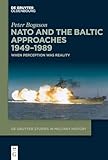NATO and the Baltic Approaches 1949–1989 : When Perception was Reality / Peter Bogason.
Material type: TextSeries: De Gruyter Studies in Military History ; 7Publisher: München ; Wien : De Gruyter Oldenbourg, [2023]Copyright date: ©2023Description: 1 online resource (XVI, 622 p.)Content type:
TextSeries: De Gruyter Studies in Military History ; 7Publisher: München ; Wien : De Gruyter Oldenbourg, [2023]Copyright date: ©2023Description: 1 online resource (XVI, 622 p.)Content type: - 9783111234625
- 9783111235769
- 9783111235752
- 355/.0330479 23/eng/20231023
- UA646.53
- online - DeGruyter
- Issued also in print.
| Item type | Current library | Call number | URL | Status | Notes | Barcode | |
|---|---|---|---|---|---|---|---|
 eBook
eBook
|
Biblioteca "Angelicum" Pont. Univ. S.Tommaso d'Aquino Nuvola online | online - DeGruyter (Browse shelf(Opens below)) | Online access | Not for loan (Accesso limitato) | Accesso per gli utenti autorizzati / Access for authorized users | (dgr)9783111235752 |
Frontmatter -- Foreword -- Contents -- Abbreviations -- Chapter 1 Introduction -- Chapter 2 Initial ideas for defending the Baltic Approaches -- Chapter 3 NATO’s military organisation and initial plans -- Chapter 4 NATO in control: Annual Review and intelligence reporting -- Chapter 5 Denmark almost alone -- Chapter 6 NATO Policy and Danish military issues in the 1950s -- Chapter 7 NATO’s New Approach and The Danish “No” to nuclear weapon: A Janus Head? -- Chapter 8 West Germany’s rearmament -- Chapter 9 The Creation of Baltap -- Chapter 10 The Warsaw Pact and its Tactics – as seen by NATO -- Chapter 11 The 1961 Berlin crisis -- Chapter 12 Making BALTAP operational: Organising for WAPA threats -- Chapter 13 Making BALTAP operational: Naval tactics in the 1960s -- Chapter 14 Towards flexible response and new NATO bodies -- Chapter 15 NATO-reinforcements -- Chapter 16 Crises in the 1960s -- Chapter 17 Towards NATO missiles in the 1970s -- Chapter 18 NATO and the Baltic Approaches in the 1980s -- Chapter 19 Conclusions -- Sources and References
restricted access online access with authorization star
http://purl.org/coar/access_right/c_16ec
The theme of the book is the creation of tactics for littoral warfare – as opposed to the more common blue ocean perspective. Themes are how NATO perceived the goals of the enemy; the purposes of the NATO organisations, the military instruments they had to organise, the organization of cooperation among units from sovereign states, and how they tested their military capabilities. Research is based on war plans and tactics of the Danish and West German navies and their planned support from air forces. We follow the modernisations of the navies from guns to missiles. Tactical discussions among military top offi cers are laid bare, and intelligence reports about the Warsaw Pact and its military capabilities are presented. Exercises are analysed based on the military reports.
Issued also in print.
Mode of access: Internet via World Wide Web.
In English.
Description based on online resource; title from PDF title page (publisher's Web site, viewed 26. Apr 2024)


